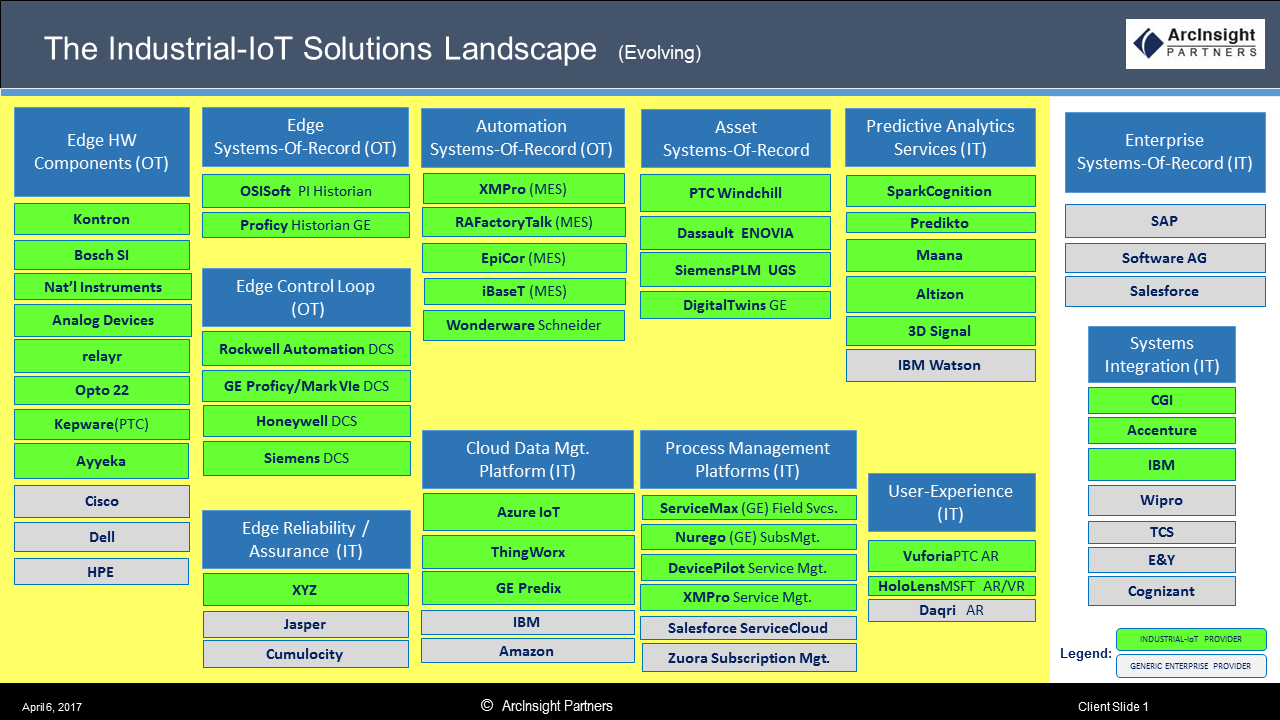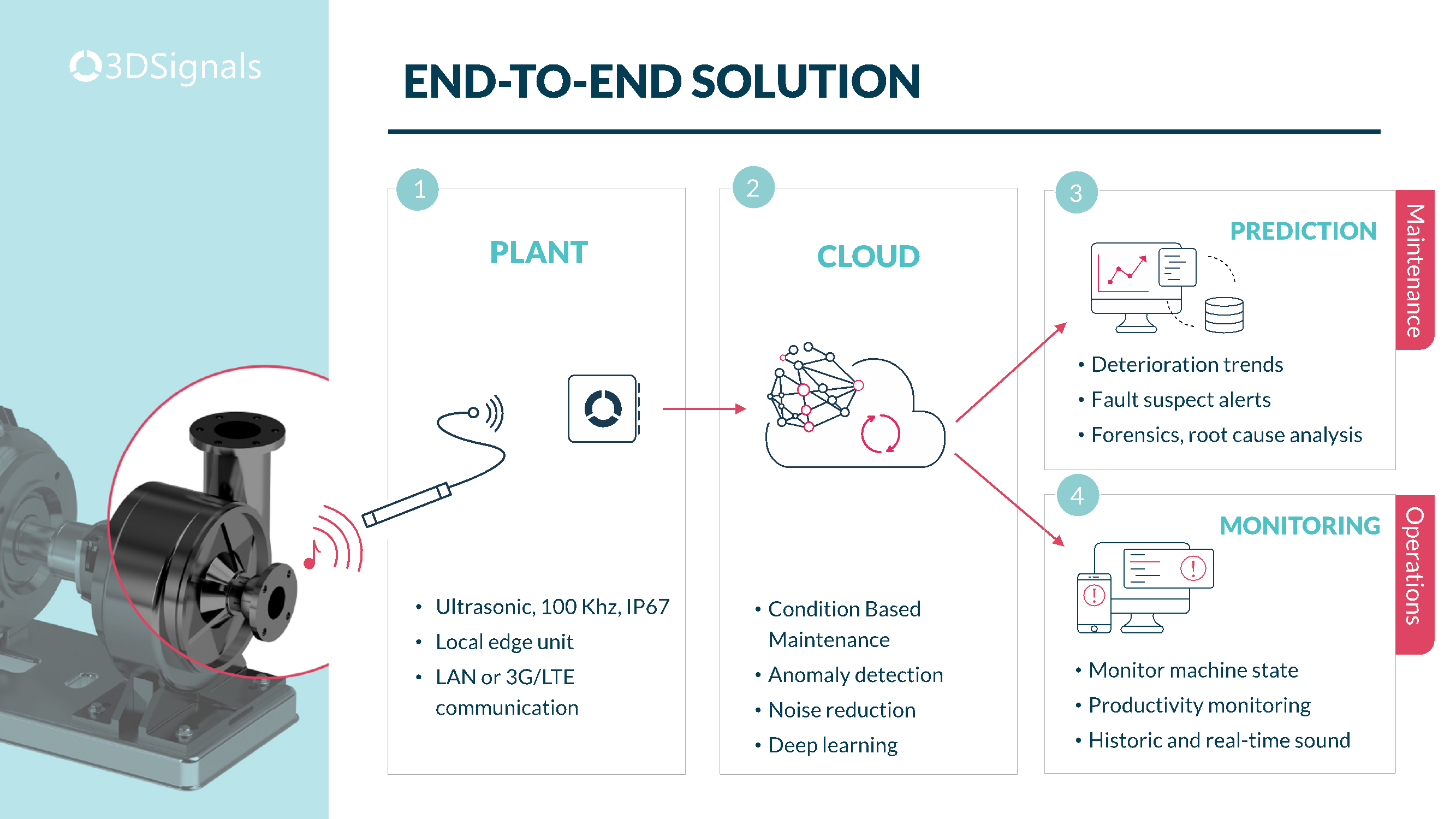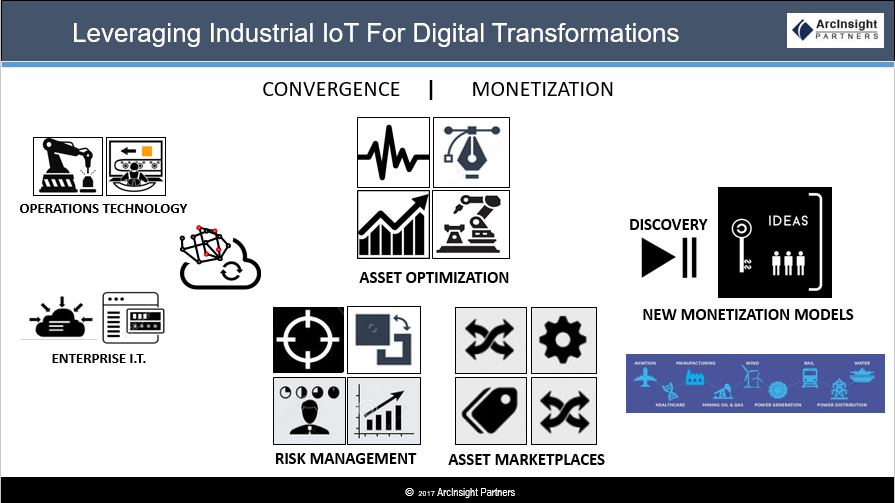Deploying AI-powered Sensors In Industrial IoT
As industry analysts focused on the Industrial Internet-of-Things, ArcInsight Partners analysts spend a lot of time with many many 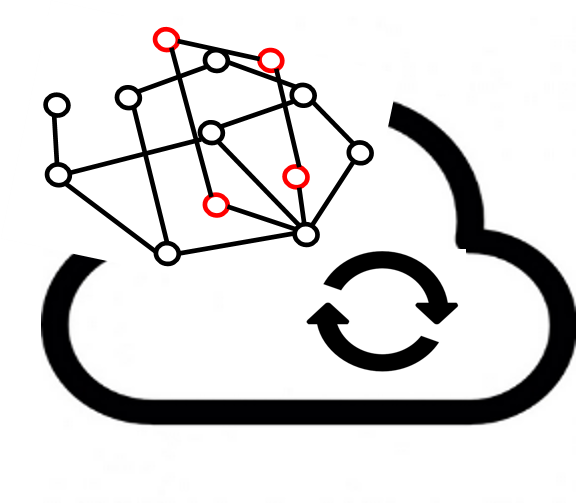 interesting companies around the world, working towards developing clarity on the ultimate goal of IIoT – Analytics & Monetizable Value-Creation.
interesting companies around the world, working towards developing clarity on the ultimate goal of IIoT – Analytics & Monetizable Value-Creation.
In early 2022, ArcInsight Partners published segments into which most of these companies fall into. The companies range from sensors, connectivity, data platforms, analytics tools providers, as well as integration players.
A draft version 2.0 of its market-map of IIoT Analytics players is shared here.
Arcinsight Partners’ Praas Chaudhuri Met Up With Amnon Shenfeld, CEO Of 3dsignals, A Very Interesting Company Based In K’far Sava On The Outskirts Of Tel Aviv, Isreal. Over A Long Coffee Session The Two Ended Up Exploring A Wide Variety Of Aspects Concerning Industrial-IoT’s Future, And The Emerging Analytics Space Enabling Its Steady Evolution.
 Deploying Artificial Intelligence Into Industrial-IoT:
Deploying Artificial Intelligence Into Industrial-IoT:
Explorations With Amnon Shenfeld, CEO & Co-Founder Of 3DSignals, And His AI Team Based in Tel Aviv.
PRAAS: You And I Have Talked Earlier About The Interesting Deep Roots In Physics And Artificial Intelligence The 3DSignals Team Comes From. And This Includes Using Deep-learning For Machine Vision In Autonomous Vehicles (A Bleeding Edge Use Case Today). Tell Me About Yourself, The Team’s Background, And How It Got Started.
AMNON: I am software engineer by training and have a background in software development, specifically in the embedded signal processing and machine learning space.
I started thinking about the idea for 3DSignals in 2013 while on a train ride from Cambridge to London. The train started to make a lot of strange sounds. Then suddenly there was a very loud, alarming noise — one that made everyone stop what they were doing and wonder if they should hold onto something. The noise passed after a while and everything was okay. But it got me thinking if there was a technician on board, he or she would probably be able to tell almost instantly from the noise what the problem was. More importantly, that expert could easily determine whether it was a sign of danger and how to fix it after we had reached our destination
That germinated the core idea behind the venture. Together with two friends (all experienced engineers), we started to work on this idea of a sound-based ultrasonic remote asset monitoring and predictive maintenance platform.
This sound-based maintenance discussion was particularly interesting to me since I worked on many projects, back in the 1970s, with intercoms mounted on control equipment cabinets. The intercoms were designed for operations and maintenance to use in order to communicates, as wireless communications was very expensive in those days and not as reliable as today. Many operations and maintenance people also relied on the intercoms to remotely listen to equipment, in order to diagnose problems and check on the health of equipment.
After developing the technology, we tested it in a steel production plant that was innovative enough to allow us to experiment around their heavy machinery.
It didn’t take very long for the system to detect meaningful anomalies and save the factory hundreds of thousands of dollars by preventing unpredicted downtime. Six months after beginning the experiment, we quit our jobs and formed the company 3DSignals with our first design partner.
We soon attracted some initial investors including an Isreali VC firm Grove Ventures.
PRAAS: 3DSignals has a unique approach leveraging AI techniques on acoustic signals from machines, as a way to predict machine failures. Tech giants (such as Google) have applied deep learning to recognize the spoken sound of human languages. But few companies have ventured using deep learning to develop an AI solution that’s good at listening to other acoustic signals such as the sounds of machines.
What Makes Acoustic Signal Analysis Unique, Compared To Certain Common Industry Practices That Use Say, Vibration Monitoring ?
AMNON: We specialize in the application of sound-based predictive maintenance for industrial and manufacturing equipment. In the case of machine predictive maintenance, sound has excellent potential to identify anomalies because it’s easy for humans to understand — even if they are not physically near the machine. An anomaly in sound can be localized to its source after identified. With our proprietary hardware and deep learning software system, customers listen to their machines with ultrasonic sensors, anticipate problems with real-time alerts, and reduce unplanned downtime with predictive analytics.
Acoustic data isn’t a new technology. The innovative aspect is the use of data that stems purely from the sound emitted from machines to the air around them. The modern technologies we’re bringing to the table include ultrasonic sensors developed specifically for harsh industrial environments, as well as innovative deep learning predictive analytics software that learn to recognize specific acoustic signatures. For example, we can monitor a mechanical bearing subjected to extreme dynamic stress. When the first crack appears, the bearing will produce a unique ultrasonic pattern that indicates trouble ahead. 3DSignals’ system identifies and preemptively alerts operators of various failure states including bearing friction, shaft misalignment, blocked filters, lack of lubrication and others before they become a detriment to the machinery.
Conditional acoustic monitoring has three main advantages over other sensing techniques:
- Early detection: As changes occur in rotating mechanical equipment, the subtle sonic anomalies are detected before looming failure occurs, often sooner than vibration, temperature and audible changes are noticed. Looking big picture, a single acoustic sensor can monitor an entire machine hence detecting shifts in sequence of components operation. Other sensors are more discrete, isolating each individual component rather than the accounting for the whole process.
- Ease of installation: A single, freestanding Predisound™ sensor collects data from an array of components that traditionally would require dozens of outmoded monitoring units. Installation of our equipment takes one day, with no machine downtime or network access.
- Sound is intuitive: Listening to the hum of a machine comes naturally. Often, engineers and maintenance experts can detect a problem simply by tuning in to the acoustics. Using patented sound-monitoring algorithms, we identify machines operating under high-risk conditions and track physical performance parameters including RPM, flow rate and operational load. The platform allows on-demand root-cause analysis, precautionary repair prompts and optimized operational efficiency.
[ Airborne ultrasonic sensing has been used as a tool for machine diagnostics and predictive maintenance for more than two decades. Using handheld instruments that measure small changes in airborne frequencies as low as 40 kHz, technicians can detect changes in machine behavior caused by damaged moving parts, congestion, and other issues. Acoustic sensing is different than temperature and vibration sensing because it measures sound waves through air, rather than using data from numerous sensors at specific diagnostic sites.
But even without instruments, experienced technicians can often sense and identify changes in machine behavior just by listening. This skill, which is learned over many years on the job, inspired a team of engineers and computer scientists to develop deep-learning neural networks (DLNN) that can be trained to do the same thing at ultrasonic frequencies. ]
PRAAS: Yes. But What Made You Pick Acoustics As The Sensor Signal Of Choice To Analyze ?.
AMNON: Acoustic data isn’t new in and of itself, but the use of airborne acoustics is new. We focus on the data that stems purely from the sound emitted from machines to the air around them. The modern technologies we’re bringing to the table include ultrasonic sensors developed specifically for harsh industrial environments, as well as innovative deep learning predictive analytics software that learn to recognize and alert on specific acoustic signatures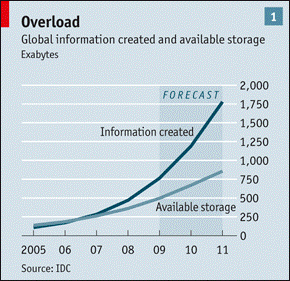 which identifying specific failure states.
which identifying specific failure states.
The common approach to Industrial IoT requires the spreading of vast numbers of data collection motes (sensors). This in terms increases the gap between the collected data and analyzed data (value) which is generated. This gap is apparent even in terms of available storage compared to generated raw data.
We are not simply generating acoustic data. We generate valuable insights regarding large collections of machines and cooperative processes with a minimum number of sensor motes. This is the revolutionary aspect of air-borne acoustics compared to run of the mill contact based sensing methods such as vibration, temperature, pressure, etc.
It is akin to attempting to recognize the song being played by a massive philharmonic orchestra by monitoring the notes played separately by each instrument and trying to reconstruct the harmony and identify instruments or groups of instruments playing out of tune.
Each instrument may be playing the right notes and seem “healthy”, but by monitoring each instrument separately, the task of identifying an instrument which is playing the right notes at the wrong times becomes herculean and verges on the impossible. As opposed to this, our approach is reversed. We monitor orchestras of machines and not single elements.
Takeaway: The Human Brain Exploits Sensor Fusion To Create “Machine-Perception”
[ While vibrations are technically a form of acoustics, airborne acoustic monitoring allows maintenance engineers and technicians to listen to equipment and tap into the intuitive human capacity of sound-based diagnosis (looking at a vibration readout graph doesn’t trigger the same intuition regarding the machine’s actual problem). It also represents sensor fusion, as a machine working under different loads in different conditions will sound differently. Using signals like acoustics, which are intuitively meaningful to maintenance experts, will be a big step in bridging the gap, with a symbiotic relationship between the IIoT hardware, software and humans. ]
Takeaway: The Human Annotation Input Remains An Important Part Of Most Artificial Intelligence Model Creation Efforts Today.
[ Airborne acoustics will help address the first challenge. Allowing a human to hear how a machine sounded at a specific moment in time will make it easier to label the data and speed up the herculean task of building high quality, labeled databases. ]PRAAS: One Of Your Clients, Enel Has Already Generated Significant Value Using Your Acoustic Signal Analysis Approach. Like To Hear About Your Experiences Deploying CbM (Condition-based Monitoring) At Enel Greenpower.
[ ArcInsight Partners comment: For confidentiality reasons, technical details of this client’s IIoT deployment are withheld from the article. Enel reports that its technology saved hundreds of thousands, or even millions, of euros by detecting a malfunction in the hydroelectric power station of Italian company Enel. The plant is located in northern Italy. The malfunction in the power station of Enel Green Power, Enel’s renewable energy division, was discovered, only three weeks into 3DSignals’ installation of the monitoring system. The fault, which was in an oil valve, was identified using 3DSignals technology during the routine operation of one of the turbines in the station, something other monitoring systems failed to detect. Early repair of the malfunction avoided a lengthy and costly shutdown of the turbine. ]PRAAS: There Is Much Upfront “Learning” Effort To Ensure Predictions Are Accurate (And Early Enough) For Engineers To Take Action On Impending Failures. How Does Deep-learning Lend Itself To Working Across Acoustic-signals From Diverse Industrial Machines ?
AMNON: We’ve created client-friendly data retention and data transmission policies that help onboard clients very fast in a scalable manner. Our proprietary sensors harvest data from the factory from the minute they are placed near the production line or power plant, sending the raw data remotely to our cloud-based monitoring network. With a team of acoustic engineers at the ready, our data hub securely analyzes data detecting shifts in the sound platform. Through patented sound-monitoring algorithms, our deep learning neural network identifies first time machine deterioration, notifies the operator and logs the acoustic anomaly for future alerts.
We identify five discrete acoustic signatures which indicate developing electro-mechanical failure:
- Loud sporadic bangs
- Repetitive banging
- Whining/Grinding
- Hissing
- Electrical discharge/Arching
Based on collected data and over time, we can apply more advanced pattern recognition strategies to identify process specific or machine specific problems which are relevant to our customers.
PRAAS: An Often Raised Question Among The AI Community Is The Challenge Of Finding High-quality Annotated Data Sets For Use In Supervised Or Unsupervised Learning. How Did 3DSignals’ Own Approach Succeed In Getting Around This Barrier ?
AMNON: At 3DSignals, we collect our own data sets in real time. This enables us to continually access historical data and sound trends enabling constant monitoring, incident forensics and root-cause analysis, as needed. Because we are using sound which is a human relatable, intuitive signal, the task of labeling data is much easier than with the case of other more abstract signals such as vibration.
[ Annotating Training Sets For Classification: Idea to send interesting sound samples to ‘sound experts’ that can give us immediate feedback on what a sound means. Using this feedback, we can very quickly teach our learning algorithms to perform the same sound-based diagnostics.”3DSignals uses ultrasonic microphones that are placed near machines to continually record sound (shown above). The audio data is sent to a Cloud-connected unit for processing by a DLNN, which classifies sounds as healthy operations, or as any diagnoses provided by the team’s algorithm specialists. Trained with the ability to classify various sounds, the DLNN can independently identify issues within minutes. This way, technicians on the floor can attend to problems as quickly as possible. ]
PRAAS: Let Us Drill-down A Little Bit Into PrediSound, 3SSignals Industrial-IoT Solution Offering.
AMNON: Its ruggedized for the plant floor. 3DSignals specially developed the sensors for harsh industrial environments and uses highly directional microphones to filter out ambient noise. The system, which was designed with the highest security standards can be deployed in minutes and requires only a power supply and network connection. The sensors can connect via wired ethernet or wireless LTE cellular networks, and the software and data can be hosted on either a public or private cloud. The system can be connected with most commercial Cloud services, including Microsoft, Google, and Amazon. Diagnostics and continuous sound profiles can be read on the company’s proprietary app.
It has specially designed low-footprint sensors that do not require low proximity to machines, and no wiring. It has data-collection and edge processing installed right next to sensors and run the first level of signal analytics. You also have a mobile app that engineers can use at site or remotely to hear the signals first-hand. This is an amazing achievement.
PRAAS: How Does The Process Of Deploying PrediSound (As A IIoT Solution) Work On The Field ?
AMNON: There are a few key planning steps the client work through with us, in order to get the best value from PrediSound.
Targeting The Most Critical Device: Choosing which process / machine to monitor. You already know from experience which failures and inefficiencies are most important & expensive for your business.
Installing A Non-Intrusive Sensor: To monitor without changing the mode of operation or any working parameters, airborne sensors do not touch or interfere with work and can simply be placed next to the machine. The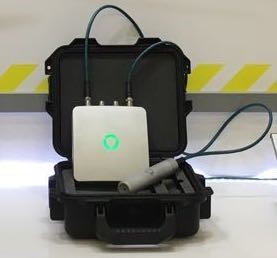 3DSignals sensors is simply positioned near the relevant machine. The ultrasonic sensors are mounted near rotating equipment and communicate with an embedded computer which detects abnormal audio patterns. This device communicates to the cloud using LTE cellular communications. It only takes a few hours before the machine becomes visible in the anomaly detection and tracking dashboard.
3DSignals sensors is simply positioned near the relevant machine. The ultrasonic sensors are mounted near rotating equipment and communicate with an embedded computer which detects abnormal audio patterns. This device communicates to the cloud using LTE cellular communications. It only takes a few hours before the machine becomes visible in the anomaly detection and tracking dashboard.
Remote monitoring: 3DSignals cloud software leverages deep learning algorithms, including the application of predictive analytics for sound signal processing, the definition of normally-operating audio patterns, the aggregation of data, along with the creation of alerts and report generation. In addition, the device communicates with on-site systems, including asset management and automation, over a standard Ethernet.
Ultrasonic airborne acoustic sensors then become the ears of the system, which predicts electro-mechanical machine failures by detecting anomalies in sound when compared to optimally running machine patterns. The PredisoundTM platform assimilates and learns a wide array of dynamic parameters and phenomena that affect machine during their work phase.
Expert support backed by deep learning algorithms: To identify developing incidents in real-time and attach them to known causes, background noises are filtered out and the clean signal is analyzed for anomalies. The data can be accessed through a web app from any device, anytime and anywhere, and you can simply listen to your machines as if you were standing right next to them. To make sure you never miss important developments, the real-time dashboards are backed by monitoring analysts who supervise the audio and algorithmic results.
Condition Based Maintenance: The O&M team is supported with alerts, insights and tools to identify developing equipment deteriorations. Our monitoring experts are there to guarantee fast incident discovery and effective response 24/7.
PRAAS: What Does Your Business Model & Go-to-Market Look Like ?
AMNON: The first clients for 3DSignals include heavy industry companies operating machinery (such as circular cutting blades in mills or hydroelectric turbines in power plants). These companies started out by purchasing the first tier of the 3DSignals service that does not use deep learning.
[ArcInsight Partners comment: 3DSignals has a three-tier go-to-market strategy, and it has deployed ths very effectively in the marketplace.The first tier of service uses software that relies on basic physics modeling of certain machine parts—such as circular cutting saws—to predict when some parts may start to wear out. That allows the clients to begin getting value from day one.)
The second tier of the service uses a deep learning algorithm and the sounds coming from the microphones to help detect strange or unusual noises from the machines. The deep learning algorithms train on sound patterns that can signal general problems with the machines.
The third tier of the service (also uses deep learning) classifies the sounds as indicating specific types of problems. Before this can happen, though, the clients need to help train the deep learning algorithm by first labeling certain sound patterns as belonging to specific types of problems. “After a while, we can not only say when problem type A happens, but we can say before it happens, you’re going to have problem type A in five hours. When trained, the 3DSignals deep learning algorithms are able to identify predict specific problems in advance with 98 percent accuracy.
Current clients using the 3DSignals system have not yet begun taking advantage of this classification capability; they are still building their training data-sets by having people manually label specific sound signatures as belonging to specific problems. “It’s important for us to be specialists in general acoustic deep learning, because the research literature does not cover it,” according to Yaer Lavi, the chief algorithmic scientist at 3DSignals. ]
PRAAS: What Were Some Your & Client’s Field Experiences Deploying A Complete Monitoring Solution, Especially The Engineering And Calibration Efforts?
AMNON: We actually think that the IIoT hype cycle is still in its early stages in many ways. While there’s a lot of excitement about the potential to apply data-driven algorithms to large data streams from industrial assets, IIoT still has a while to go before hitting a mainstream productivity plateau.
One of the main insights we’ve gleaned from the space so far is that there are still data challenges that need to be overcome to push IIoT predictive maintenance technologies into mainstream adoption and success.
[ The Issues Of Data Quality: Much of the data quality challenges will be addressed by new, deep learning algorithms that mimic the learning faculties of the human brain and can be used to build more accurate predictive models. These deep learning models will be able to apply insights from previously labeled data to new, unlabeled data so both predictive and prescriptive analyses will become even more accurate over time. It’s only with optimal predictive models that any array of connected hardware devices can provide maximum return on investment (ROI) and benefit for decreasing human errors, reducing downtime and increasing average production.To overcome the challenge of fragmented technologies and operations, maintenance engineers and technicians will need to start relying on classic signal outputs, such as vibration, temperature, power consumption, etc., as well as new smart sensors, such as deep learning, powered, airborne acoustics. Such sensor inputs will increasingly play a larger role in IIoT predictive maintenance. Engineers and technicians have, of course, always diagnosed machine problems simply by listening to them. However, humans can’t be physically next to every machine at all times during operation and also have a hard time filtering out other noise interference present in harsh industrial environments. ]
PRAAS: 3DSignals Serves Its Clients From Its Base At K’Far Sava In Isreal. You Have Also Raised A Good Bit Of Funding So Far In Your Initial Rounds. Clearly You Have Great Deployments In Europe, And Ambitious Going Forward. Are There Other Locations Where You Have Teams To Serve Local Clients?. What Are Your Plans To Expand Operations Into North America And Asian Regions ?.
AMNON: We are currently serving clients in Europe and North America. We see huge growth potential moving forward. Today, there are many millions of industrial assets out there that are not yet modernized. Similarly to how the e-commerce revolution forever changed retail, the smart industry revolution is about to disrupt conservative manufacturing industries.
By some estimates there are 60 million machines in factories throughout the world and 90 percent are not connected. Meanwhile, 70 percent of the machines are more than 15 years old.
Sound monitoring offers a quick and painless method to upgrade old assets in factories and plants across multiple sectors without mounds of equipment or challenging integrations with legacy controllers and networks. Based on this growing market opportunity, we seek to democratize sound as a meaningful tool serving predictive maintenance needs, as well as operational efficiency and safety applications.
PRAAS: Finally, Tell Me About Your Personal Opinions Of Technologies Such As Machine Learning, AI & Deep Learning, As They Are Currently Being Marketed In The Industrial-IoT Space.
AMNON: While there’s a lot of excitement about the potential to apply data-driven algorithms to large data streams from industrial assets, IIoT is heading into the trough of disillusionment. Two major challenges must be overcome to push IIoT predictive maintenance technologies up the slope of enlightenment and spark mainstream adoption and success.
Poor Data Quality : Big data went through its own hype cycle, but is now more firmly grounded in the realization that merely collecting large amounts of data is insufficient to achieve meaningful insights. For IIoT predictive maintenance, the data challenges are twofold. Firstly, it’s difficult to obtain high quality, labeled data from industrial machines to begin with. Secondly, it’s even more challenging to then apply that data to provide human engineers and technicians with relevant and actionable condition-based maintenance insights.
Gathering large volumes of raw, unlabeled data is relatively easy, but when attempting to build learning algorithms for IIoT predictive maintenance platforms, the algorithm is only as good as the quality of data labeling (i.e., assigning each piece of data a useful tag or label that makes it somehow informative and useful). Building databases of high quality, labeled data is a much more technologically challenging and time-consuming endeavor.
Fragmented Technologies and Human Operations: Because industrial maintenance software platforms, sensors and operations are currently highly fragmented, it’s a challenge to fuse sensor data (e.g., signals based on vibration, temperature, power consumption, etc.) with actual events or maintenance activities that humans carry out on machines.
Many existing condition-based maintenance solutions, such as vibration analysis via a handheld device, require sampling and diagnostics by human technicians going from machine to machine. These contact-based methods can fall victim to producing biased, one-sided results depending on the location of the sensor and the experience of the technician, and aren’t constantly monitoring and sending alerts in real time. Other non-handheld sensors with “smart” monitoring capabilities require complex integrations, training and retrofitting of old industrial assets.
PRAAS: What Can IIoT Do To Mitigate Some Of These Challenges?
AMNON: IIoT is helping to change this, but so far in the hype phase, IIoT predictive maintenance solutions have mainly consisted of software to analyze data collected from sensors designed and manufactured by third parties. In many cases, users and implementers of such software solutions don’t control the sensors or the data origins. Therefore, they are very exposed to garbage in, garbage out scenarios where false-positive alerts rule and maintenance teams eventually ignore valuable alerts as they are trained to distrust the outputs of such systems.
Reliability monitoring software also needs to be highly reliable. The challenge is to bridge the gap between human maintenance engineers, sensors and enterprise resource planning and monitoring software, especially when working within harsh industrial/manufacturing environments, such as steel plants or oil rigs, or with equipment spread across remote locations, such as energy generating turbines.
Much of the data quality challenges will be addressed by new, deep learning algorithms that mimic the learning faculties of the human brain and can be used to build more accurate predictive models. These deep learning models will be able to apply insights from previously labeled data to new, unlabeled data so both predictive and prescriptive analyses will become even more accurate over time.
To overcome the challenge of fragmented technologies and operations, maintenance engineers and technicians will need to start relying on classic signal outputs, such as vibration, temperature, power consumption, etc., as well as new smart sensors, such as deep learning, powered, airborne acoustics. Such sensor inputs will increasingly play a larger role in IIoT predictive maintenance.
About Amnon Shenfeld: Amnon Shenfeld is founder and CEO of 3DSignals, a company developing a disruptive predictive maintenance IoT system that uses deep learning algorithms to analyze the airborne sounds of machines and predict malfunctions. Before 3DSignals, Amnon was the VP R&D of a computer vision company, Eyesight Technologies, and prior to that, held several R&D roles for global corporations and research laboratories.
About Praas Chaudhuri: Praas Chaudhuri, Co-founder & Principal Analyst of ArcInsight Partners began his early career as a chemical engineer with hands-on experiences at oil-refining plants, industrial cooling & waste-water systems, and coal & gas-fired power generating units. He began writing process control software for manufacturing environments way before IIoT became a buzzword. At his Silicon Valley base, Praas combines this engineering & process control background, with his strategy consulting experiences working with & researching leading-edge enterprise analytics, and emerging enabling technologies that make IIoT possible. He is a regular speaker & panelist at various global conferences. He has also written well-received articles on subject of analytic insight as the core value of IIoT initiatives. He has a Bachelors degree in Engineering & Process Control; a MBA in Strategic Marketing & Finance, and did Graduate-level research in Advanced Decision Analytics.
